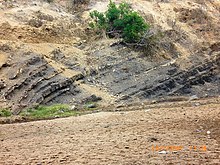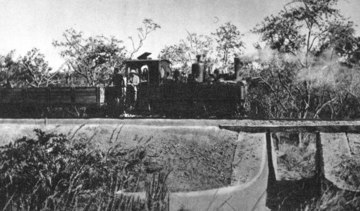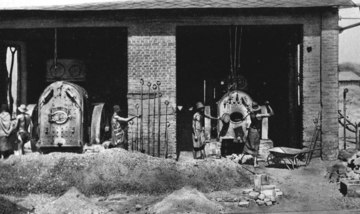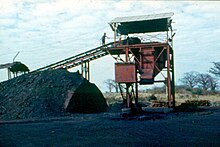Tete coal field
The Tete coal field is located in the Mozambican province of the same name, mainly in the Changara district and between the city of Tete and Moatize . Mining took place here during the Portuguese colonial times.
It is believed that the world's largest coal deposits are currently located here. Up until 2012, mining concessions were granted for 34% of the area of the province, in the future these could be expanded to up to 60%. Optimistic estimates assume a total volume of 23 billion tons of coal reserves. The open pit mine introduced in 2011 will lead to extensive landscape destruction. The accompanying air pollution from dust and heavy metals is a serious problem.
The profitability of the projects is threatened by the reluctance to restore or expand the rail links to the export ports of Beira ( CFM Central ) and Nacala (CFM North).
Société géologique et minière du Zambèze
The Société géologique et minière du Zambèze, founded with Belgian capital, was the first to exploit the coal deposits in Tete. At the end of the 1920s, the total deposits were estimated at 105 million t. Annual production was around 20,000 tons until 1930. The main consumers were the local sugar factories, such as those of Companhia da Zambézia and the local railways of the plantations. A rail connection to the ports came later.
Companhia Carbonífera de Moçambique
The Companhia Carbonífera de Moçambique, capitalized with forty million , was founded in Lisbon in 1947/48. The previous mining operations in the region were taken over centrally. Belgian financiers also initially had a share of sixty percent, the Companhia de Moçambique held another 30% and the state held the remaining tenth. The output rose from 1945, when it was 12,000 tons, to around 570,000 tons in 1976. The total deposits in 1965 were estimated at 700 million t. In 1972, 6,328 workers were employed in 128 shafts (including those for gold and precious stones) of the company.
The mining of the coal, which has caloric values of 6200 to 7800 kcal / kg, was significantly cheaper than that in Witwatersrand. The high transport costs and taxes ensured that both products were sold at almost the same price per ton, e.g. B. 1963, Esc. 408-410 were landed in Nacala .
In September 1976, it came in the pit Chipanga 6 to firedamp disaster that killed 68 buddy. In August 1977, another 3 56 miners lost their lives in Chipanga . There was unrest among the population because of the poor safety standards. Several people responsible, including the director of the CCdM, were killed. The government then nationalized the mining industry.
State enterprise

The state Empresa Nacional de Carvão de Moçambique, or CARBOMOC for short, produced around 70,000 t in the first year. The dismantling turned out to be difficult as many of the Portuguese specialists had left. The workers hardly had any protective clothing and they often dug without shoes. The coal was mainly converted into electricity in the country or used in energy-intensive cement or sugar factories.
Specialists from the GDR had already provided assistance after the accidents. The collaboration was formalized during Erich Honecker's visit to Mozambique, 22. – 24. Feb. 1979. In exchange for technical assistance, which was coordinated by the Black Pump Combine , 250,000 tons of coal were to be delivered. Only after the start of delivery did it become apparent that it was poorly suited for the planned coking , so that German involvement was restricted from 1984 onwards.
After the accidents and the increased terrorist attacks by the, by the South African apartheid regime, the US and the BND funded RENAMO on transport infrastructure in the region - it was above all the systematic attacks on the railway line Sena-Moatize-Beira and power - was the annual production to 20,000 tons. Thanks to the development aid provided with the construction of a diesel power plant, the construction of a new tunnel, etc., a production target of 400,000 tons was achieved for 1981. The transport remained problematic for a long time because of the fighting. At times, funding came to a complete standstill from 1985 until it was resumed at the end of 1987. In that year they extracted 40,000 tons. In 1990, all but two shafts were shut down for safety reasons.
Due to the political adversity, CARBOMOC has never made a profit.
Since 2004
From 1999 onwards, geological surveys of foreign companies began nationwide as part of the beginning of privatization, through which numerous central government politicians were able to enrich themselves unchecked. The Mozambican Mining Act expressly does not allow the local population to participate in the concession fees. 2004–2012 four major licenses were awarded for the region.
The concession for the existing mine of the former state-owned enterprise went to the Brazilian company Vale in 2007 , with the participation of the Korean Pohang Iron and Steel . With investments of US $ 900 million, production began to be converted to open-cast mining, which began in 2011.
By the beginning of 2012, production had been expanded to two million tons per year. Mitsui acquired a 15% stake in January 2014 for US $ 450 million, plus an investment commitment of a further US $ 188 million. In Phase II, which should be achieved in 2015, the aim was to increase the mining volume tenfold.
A 270 MW coal-fired power plant on site was planned in 2013 and should go into operation in early 2018. It was never built. In addition to the main owner ACWA Power of Saudi Arabia (56.5%), the mine owners should also be involved.
After losses of resp. US $ 120 and 145 million in the first two quarters of 2019, the company announced that it intends to close the mine at the turn of 2020 "for three months for maintenance purposes". In March 2020, 200 employees were flown home to Brazil, the loss in the first quarter was US $ 238 although almost two million tons were extracted in the first half of the year.
- Forced relocations
Thousands of people were relocated in order to be able to develop the large open-cast mine. Although they received new houses, significantly more money flowed into the pockets of local politicians who made the action palatable to the population. This, as well as ignoring environmental regulations, is part of the usual behavior of all subsidiaries of the Vale Group worldwide.
The new settlements built by the company from 2009 to 2011 near Moatize (the “25 de Setembro” district) and the village of Cateme were handed over to the government after completion. Initially, 1,049 households were relocated to the localities 35–55 km away from their old homes. From Cateme you can reach the next main road over eleven kilometers of dirt road.
Around 800 small business owners who made traditional mud bricks were cut off from their raw materials by the barriers around the opencast mine and lost their businesses. Likewise, farmers can only get to their pastures via long detours.
- environmental pollution
The influx of thousands of workers for the opencast mine since 2008 has led to severe housing shortages and explosion in rents.
There is no water supply from pipes in the smaller towns. The natives either draw stale, undrinkable water from pits or buy it from vendors who come in tank trucks. Heavy metal pollution is so high around Tete that the use of this broth in agriculture leads to dangerous pollution of the crops.
The most serious environmental problem is air pollution from dust, which existed in the days of underground mining but has worsened significantly since open pit mining began. The blasting of the rock in particular causes large amounts of dust to be blown over the villages, which is made even worse by the frequent windpants in the dry season. Agricultural crops and drinking water supplies are also contaminated in this way until they are inedible. The vibrations triggered by the blasting lead to damage to the houses in the surrounding villages, which are simply made of adobe bricks.
Other Projects
The concession for the Benga mine was awarded to the Australian Riversdale Mining (65%) and Wuhan Iron and Steel (35%). Production started in June 2010. The following year, Riversdale was taken over by the Rio Tinto Group . The estimates of the potential of half a billion tons were revised downwards the following year. Rio Tinto wrote off $ 3 billion. The mine was sold to the Indian joint venture ICVL in July 2014 for a ridiculous price of US $ 50 million, of which the largest shareholder, the car manufacturer Tata Steel , holds 35%. At that time, an annual production of up to five million tons was announced. The planned removal of the product by barge down the Zambezi was not approved by the government in June, 2013. The mine was shut down until the railway line had the necessary capacity.
Rio Tinto had also planned to build a coal-fired power plant with 400–600 MW on site, but abandoned the plans. ICVL took up the idea for 300 MW at a construction price of US $ 1.9 billion, in a second phase up to 1500 MW should be generated. Due to the restructuring of the company in 2015, the plans were put on hold. Prospective buyers were sought in 2017, but the still lack of network expansion prevents implementation.
The Central African Mining and Exploration Company (CAMEC) also received a license in 2006. The Western Australian Beacon Hill Resources bought the local operating company Minas Moatize Limitada in 2011. The transport to the port of Beira was carried out with a fleet of forty trucks, which turned out to be expensive. The Dutch company Vitol took over sales in 2012 .
Another project was the Revuboè mine, the concession of which was initially awarded to the South African Anglo American , but which then did not invest, but instead ceded its rights to Nippon Steel . This planned to start with the opencast mine in 2016.
In 2012 it was announced that iron ore and titanium deposits had also been discovered in the province . In the Mundonguara mine , copper was mined underground as early as the colonial times until 1989. Tete Steel and Vanadium, a subsidiary of Baobab Resources, has been active since 2009. At Tenge-Ruoni, the iron ore extracted from three mines is to be processed in a steelworks to be built. In 2017 it was announced that construction was ready to begin. Attempts were made in May 2020 to win additional investors. The company's two concessions for an area of 338 km² are at Singore, 25-30 km north of Tete and 525 km² near Massamba, about 55 km to the southeast of Tete. There are also plans in 2020 to build a power plant (“Benga Power Plant”) with 350 MW together with Irish Kibo Energy , 200 MW of which will be used exclusively for mining.
literature
- Celier, J .; Le charbon en Afrique australe ; Annales de geographie, 1930, pp. 664-665
- Cuambe, Inês Selça dos Santos; A Produção do território em áreas de mineração: Estudo de Caso de Moatize-Moçambique;
- Estatutos da Companhia Carbonífera de Moçambique; Lisboa 1948 (Papelaria Luso-Brasileira)
- Gerth, Wolfgang; GDR specialists at the coal miners of Mozambique; ND, June 3, 1978, p. 11
- Grabner, Walter; 12 years GDR participation in the project “Steinkohle Moatize” in: Voss, Matthias; We left traces! The GDR in Mozambique; Münster 2005 (Lit), pp. 199-215; ISBN 3825883213
- Major investments in the Mozambican mining sector, 2000 to present; as an app. 3 (pp. 65-9) in: German, Laura; Sino-Mozambican relations and their implications for forests; 2012
- Miguel, Inês Domingos Sávio; A Companhia Carbonífera de Moçambique: evolução sócio-histórica no período 1950–1973; Postage 2009 [MA Univ. Postage]
- Ministério da Administração Estatal (MAE) - Governo de Moçambique; Perfil do Distrito Moatize; Maputo 2005
- Mosler, Günter; As a GDR foreign cadre in Mozambique: (1979–1982); Leipzig 2013 (Engelsdorfer-Verlag); ISBN 9783954885237
- Passe, José João; Indústria carbonífera no distrito de Moatize, província de Tete, Moçambique e sua influência ambiental dos solos por elementos potencialmente tóxicos; Diss. São Paulo (Br.) Univ. 2018
- Pedro, Joana; Forced Resettlements: From Impacts to Opportunities - The Case of Moatize Mine (Mozambique); 2017 (Centro de Estudos Internacionais); ISBN 9789897325809
- Orlowski, Monika; The year of coal; Mozambique Circular No. 83 (December 2011)
- Pondja, Estêvão; Environmental aspects of coal mine drainage: a regional study of Moatize in Mozambique ; Lund 2017; ISBN 9789177532903
- Silva Rêgo, Bernardo Frossard; Perspectiva de Redes na Internacionalização de Empresas Brasileiras de Construção Civil: O Caso Vale e BNDES em Mozambique; Revista Ibero-Americana de Estrategia, 2016, Vol. 15 (2016), No. 3, pp. 53-70
- documentary
- Stefano Sbrulli, O silêncio do vento, filmed in 2018, released in May 2019, funded by UNDP and nature yards, Verket.
Individual evidence
- ↑ a b A race for coal , in: Pedro (2017)
- ↑ Rufino, José dos Santos [1887–1929]; Albuns fotográficos e descritivos da colónia de Moçambique; Vol. 8: Distrito de Tété e Territórios de Cabo Delgado (Niassa); Hamburg 1929 (Broschek), p. VII.
- ↑ Estatutos da Companhia; Escritura de 27 de Maio de 1948, Portaria Ministerial de 14 de Julho de 1947, Diário do Govêrno, II série no 161, Moçambique, 1947.
- ↑ Moatize coal mines nationalized in Mozambique, ND, Sa. May 13, 1978 vol. 33, issue 112, page 7.
- ^ Neues Deutschland (ND): Fr. August 5, 1977, vol. 32, issue 184, p. 7.
- ^ Title page ND, Feb. 26, 1979.
- ^ Mozambique, the fatal attacks on GDR development workers, the politically explosive denial (1984) by the CDU-Kohl government in response to a request from the GREEN member of the Bundestag Gabriele Gottwald (now a member of the Left Party). Who is lying, who is telling the truth? Manfred Grunewald (Frauenprießnitz) and the Renamo terror victims from Thuringia. (Under Ramelow and LINKE Education Minister Holter, everything was taught at the Thuringian schools?). In: Contemporary witnesses from Oldisleben and the surrounding area. Klaus Hart, accessed on August 15, 2020 .
- ↑ Black gold comes out of the Moatize mines: GDR specialists support hard coal mining, which is important for Mozambique; ND Thursday January 21, 1988, vol. 43, issue 17, page 6 .
- ↑ On privatization in general: M. Anne Pitcher: Transforming Mozambique: The Politics of Privatization, 1975–2000; Cambridge University Press, 2002, ISBN 0521820111 . Numerous investors tried to get involved; at the height of the boom, the wildest estimates in 2015 assumed that an annual production of 95 million tons could be achieved. The share of mining in the GPD (including gas extraction off the coast) should increase from one to thirty percent.
- ↑ Human Rights Watch: Mozambique: Mining Resettlements Disrupt Food, Water (2013-05-23). 122-page report: “'What is a House without Food?' Mozambique's Coal Mining Boom and Resettlements. "
- ↑ Facing Finance: Vale: Moatize Coal Project in Mozambique (2013)
- ↑ Reason for awarding the Public Eye , 2012.
- ↑ a b Passe, José João; Indústria carbonífera no distrito de Moatize ... (2018)
- ↑ Water: Pondja (2017)
- ↑ The company was taken over by the Luxembourg Eurasian Resources Group , which was mainly supported by Kazakh capital .
- ↑ Geochemistry results highlight gold, copper and nickel potential at the brownfield Mundonguara Project. (PDF) Baobab Resources plc, November 13, 2007, accessed August 15, 2020 .
- ↑ Australian company listed on the unregulated London Alternative Investment Market . Subsidiaries: Maputo Minerals Limited, Mocambique Resources Limited, Capitol Resources Lda Baobab Mining Services Pty Ltd., Mayfair Mineral Exploration Lda.







